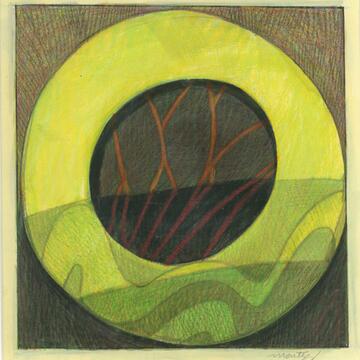Mark Mentzer Retires After 49 Years at Carnegie Mellon University


Professor Emeritus Mark Mentzer, a faculty member and staple of Carnegie Mellon University’s School of Design, has announced his retirement after an incredible 49-year career at CMU. An exemplary educator and prolific artist, Mark Mentzer was an integral part of the educations of generations of designers all while perfecting his own craft and practice.
From a young age, Mentzer’s abilities as an artist were apparent to everyone. At the age of 10, his teacher at the time helped him create his first oil painting, a depiction of a picnic table that he had built with his dad.
“I remember drawing it and my mom pointed out that my shadow made the table look like it was floating,” said Mentzer about his first painting. “She showed me how to fix it by attaching the shadow to a leg, and suddenly, the table was grounded. That moment stuck with me.”

Mark is an incredible mentor whose outstanding work ethic is inspirational. I learned how to teach by working with him.
Those of us fortunate to have been his student in First Year Design Drawing will recall him looking over your shoulder at your work and asking, “Can I have your seat?” Then he would proceed to take you on a personalized sketching journey through the content, moving at a fever pitch, fixing your mistakes, and providing play-by-play commentary the entire time. Somehow, in a class of 40+ students, he made time to teach every student individually.
To further develop his zest for art, Mentzer attended pre-high school and pre-college art programs at Carnegie Mellon University. He studied under renowned Pittsburgh art educator Joseph Fitzpatrick in the Pallets and Tam-o’-Shanters program. On top of his early education, Mentzer spent summers taking art classes, visiting museums, and gaining exposure to various works of art.
In 1969, Mark Mentzer officially enrolled in Carnegie Mellon University.
“I thought I wanted to be a sculptor, but after a semester and a half, I realized I liked the drawing process for sculpture more than the actual making of it,” said Mentzer. “That was when I pivoted to painting. I minored in printmaking and had some really great teachers who inspired me.”
During his higher education, Mentzer was also awarded a competitive fellowship at Yale as a rising senior. That experience was a real ‘high point” for Mentzer as he was nearing the end of his education.
In Mentzer’s early career, he spent time running a silkscreen operation and worked on projects for WQED and other venues in Pittsburgh. Then in the Fall of 1975, Mentzer made the switch to teaching art and design.

Lots to remember:
Howard Worner and his Wean United calendars||Tom Ruddy and sliced up car photo-templates for illustrations||Mrs. Dorothy Bell in the office||Arnold Bank with his thick glasses and Mont Blanc pen/bicycle grip||Rob Kelly meetings while chain-smoking with students at the cable spool table||Meetings with Rob & Joe every week to discuss the freshman program||Harold Corsini||Henry Moore cow works||Kyle Rislow||Lou & Maggie Marinaro||Chip Mclean and his pencil stubs||the weddings, births & passings in our community||Karen Moyer’s timeless hairstyle||Akram Midani||the student we never saw, just attaching paper bagged projects to our doors||Herb Olds||our own children speaking at the CFA Hall memorial service for Colin Boyarski; all professor’s kids||learning how to be teachers||team teaching with Dick Buchanan||being the associate head||travelling to distant cities with Bill Elliot looking at long lines of hopeful portfolios||the period of having 63 freshman/sophomores in three sections||what it’s like to have been teaching three times as long as your students have been alive||Dorothy Yanick||the DustBuster||Alessandro De Gregori||Bob & Susanne Swinehart||the decades of privilege we’ve been given to discover and share the truths and wonders of the universe with students and each other||what a life!||
“I got into teaching by accident,” joked Mentzer. “I was hired to help start a new program in drawing & color in the School of Design. Back then, drawing was more illustration-based. I wrote out a curriculum in drawing & color and broke it into four areas: drawing from observation, drawing from imagination, drawing systems, and diagrammatic conventions. We were trying to build something foundational for first year students and it was a lot of work. Myself, Rob Roy Kelly, and Joe Ballay ran the program together. Rob handled 2D design, Joe handled 3D, and I did drawing & color.
“We experimented a lot,” continued Mentzer about our approach to teaching design. “Students didn’t just get separate grades in those classes, we gave them a single grade that reflected their progress across all areas. That collaboration between faculty and students was really rewarding, but intense. We’d spread all their work out at the end of each year, spend two or three days reviewing it, and have some pretty tough conversations about what was working and what wasn’t.”
As an educator at CMU, Mentzer searched for ways to collaborate with other schools of design and helped establish exchange programs with schools in Germany and the UK, fostering global collaboration and exposure for students and faculty.

Having had the pleasure of working with Mark for 40+ years as a teacher and colleague, I can truly say that he is a remarkable human being. Whether grabbing his pencil with a twinkle in his eye or offering wisdom and encouragement to those around him, Mark’s care and enthusiasm for his work as an artist and educator never waver. I am grateful for Mark’s continuous presence in my life and for all he has graciously given me and countless others. Thank you Mark, for your profound positive impact on the lives you have touched and I wish you much happiness as you paint your way through the years ahead!
Mentzer’s approach to teaching design is heavily influenced by his artistic mindset. He encouraged students to think critically about design, not just in terms of aesthetics but also in terms of its functional and emotional impact.
“One of the first things I did every year during orientation was this grid project,” said Mentzer. “I’d give each student a small square from a larger image that they didn’t know what it was - a photo of Picasso’s face one year, an elephant another. They just had to draw their piece. Once they put their pieces up on the grid, you’d see the full picture come together. It was a way to show them that while they were here to grow as strong individual designers, they were also part of a community where everyone’s work contributed to the bigger picture.”
Mark also emphasized going to original sources rather than relying solely on digital images and photographs in order to teach students about authenticity, visual observation, and critical thinking.
“I also had this project where students had to get leaves from outside—an oak leaf, a ginkgo leaf, and a maple leaf,” said Mentzer. “As designers, you have a responsibility to go to the original source when possible. Don’t just rely on what you find online.”
This belief that style should emerge naturally from the process, not from imitating others, was a key part of Mark’s practice as an artist and designer.

“When I was in school, working from a photograph was forbidden,” said Mentzer. “You worked from life. That taught me to develop a strong visual memory. I still don’t use photographs in my work, even though my wife jokes that I’m always taking them but rarely relying on them. My paintings might look familiar, but they’re all made up—geometric shapes, designed structures, and imagined landscapes.”
“It’s funny when people see my work and say, ‘I live there!’ I tell them, ‘You live in my painting? That’s great, but it doesn’t actually exist.’”
Throughout his career, Mentzer commits himself to producing one drawing a day. This activity spanned over 50 years and resulted in the creation of countless drawings. Many of Mentzer’s works feature neighborhoods and urban structures, tabletop compositions, imaginary structures seen through windows, as well as the exploration of drawing systems and mixed perspectives. Even in retirement, Mentzer continues to draw and exhibit his work in galleries across Pittsburgh.

Mark is one of the best drawing teachers I’ve come across.
His students produced impressive work over the decades of Mark’s tenure in the School of Design. He taught them to draw what they saw in the world, in their minds, or the result of a discussion.
Drawing is a way to think through an idea.
Mark continues to draw every day. Pencils and paper. Paint and paper.
That keeps his mind alert, young, and always questioning.
Alumni often ask if first year students still have to draw by hand and the answer is yes.
If Mark had his way, that would never change.
“My influences have been very wide reaching including aspect of nature, architecture, mechanisms, etc.” explained Mentzer. “But a teacher once told me, ‘You’re only as good as your influences are obscure.’ I think there’s a good deal of truth to that. It’s not about imitating other people’s work. It’s about absorbing influences and turning them into something uniquely yours over time and effort.”
“I don’t follow rigid systems. I let the painting guide me. It’s all about structures, composition, and color.”
Looking back on his time here, Mentzer highlights Carnegie Mellon’s collaborative, interdisciplinary environment, where students are expected to engage with peers, professors, and professionals across various fields.

“I don’t give a set pitch to prospective students,” said Mentzer on his approach to student recruitment. “I ask them questions. I want to know if they’re ready to engage with a community where collaboration, critique, and deep exploration are central to design. At Carnegie Mellon, you’ll meet people from all kinds of fields—engineers, architects, writers, etc. You’ll be challenged to learn how to communicate across disciplines.”
“It’s not just about making pretty images. It’s about solving problems, challenging preconceived notions, and building meaningful connections.”
The School of Design cannot thank Mark Mentzer enough for the countless ”meaningful connections” he made during his time here.
“Every day, Mark exemplifies the qualities of an exceptional educator and person,” said Interim Head of the School of Design Eric Anderson. “His knowledge, spirit, talent, and genuine concern for others have inspired generations of students and colleagues in the School of Design and beyond. He is greatly missed, but his legacy continues to thrive!”
The School of Design will hold a celebration of Mark Mentzer's work and career on campus on March 28th, 2025.